Enterprise Leadership Assessment 1: Management, Leadership, and Teams
VerifiedAdded on 2021/05/11
|6
|1308
|32
Essay
AI Summary
This essay critically examines the distinctions between management and leadership, highlighting their respective roles and responsibilities within organizational teams. It argues that while management focuses on maintaining staff and the business environment, leadership inspires and influences employees, driving change and envisioning the future. The essay explores both formal and informal leadership styles, emphasizing how leaders identify problems, energize teams, and develop employee skills. It contrasts these qualities with the manager's role in enforcing rules and mediating conflicts. The value of leadership is discussed in terms of its power to create new systems, foster positive cultures, and facilitate effective stakeholder management. The conclusion reiterates the importance of leadership in mobilizing teams towards a brighter future, emphasizing the need for leaders to build confidence and eliminate confusion.
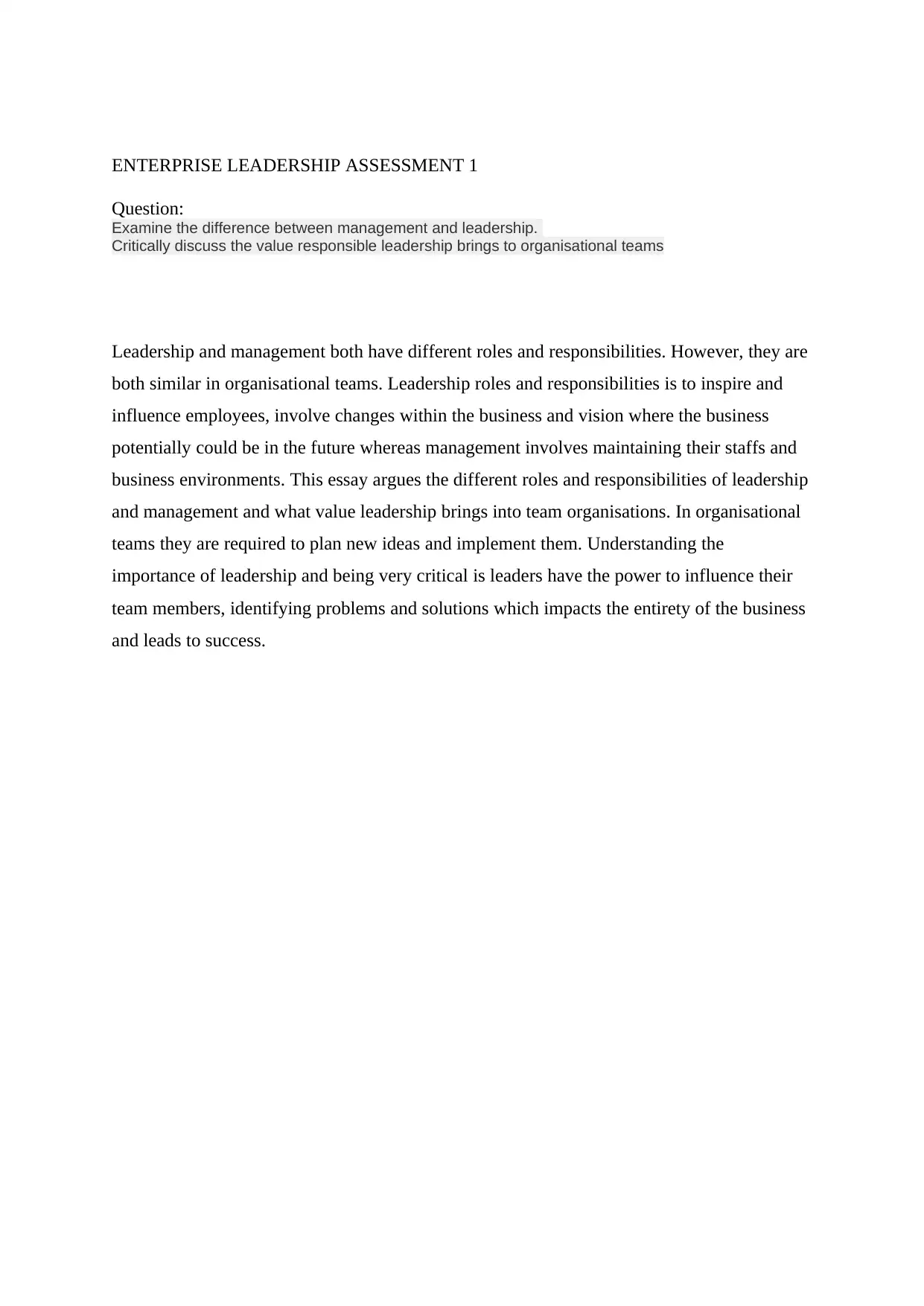
ENTERPRISE LEADERSHIP ASSESSMENT 1
Question:
Examine the difference between management and leadership.
Critically discuss the value responsible leadership brings to organisational teams
Leadership and management both have different roles and responsibilities. However, they are
both similar in organisational teams. Leadership roles and responsibilities is to inspire and
influence employees, involve changes within the business and vision where the business
potentially could be in the future whereas management involves maintaining their staffs and
business environments. This essay argues the different roles and responsibilities of leadership
and management and what value leadership brings into team organisations. In organisational
teams they are required to plan new ideas and implement them. Understanding the
importance of leadership and being very critical is leaders have the power to influence their
team members, identifying problems and solutions which impacts the entirety of the business
and leads to success.
Question:
Examine the difference between management and leadership.
Critically discuss the value responsible leadership brings to organisational teams
Leadership and management both have different roles and responsibilities. However, they are
both similar in organisational teams. Leadership roles and responsibilities is to inspire and
influence employees, involve changes within the business and vision where the business
potentially could be in the future whereas management involves maintaining their staffs and
business environments. This essay argues the different roles and responsibilities of leadership
and management and what value leadership brings into team organisations. In organisational
teams they are required to plan new ideas and implement them. Understanding the
importance of leadership and being very critical is leaders have the power to influence their
team members, identifying problems and solutions which impacts the entirety of the business
and leads to success.
Paraphrase This Document
Need a fresh take? Get an instant paraphrase of this document with our AI Paraphraser
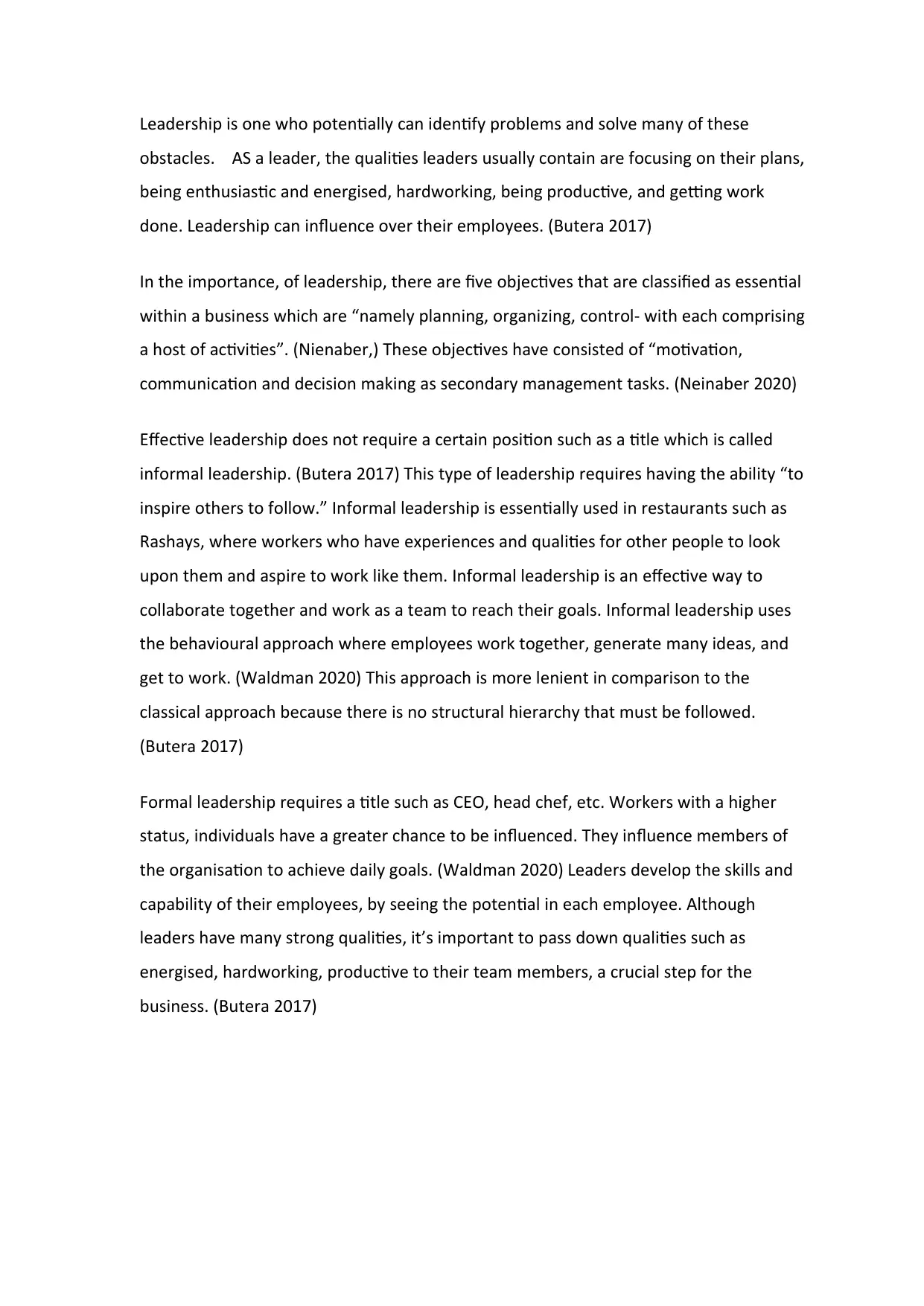
Leadership is one who potentially can identify problems and solve many of these
obstacles. AS a leader, the qualities leaders usually contain are focusing on their plans,
being enthusiastic and energised, hardworking, being productive, and getting work
done. Leadership can influence over their employees. (Butera 2017)
In the importance, of leadership, there are five objectives that are classified as essential
within a business which are “namely planning, organizing, control- with each comprising
a host of activities”. (Nienaber,) These objectives have consisted of “motivation,
communication and decision making as secondary management tasks. (Neinaber 2020)
Effective leadership does not require a certain position such as a title which is called
informal leadership. (Butera 2017) This type of leadership requires having the ability “to
inspire others to follow.” Informal leadership is essentially used in restaurants such as
Rashays, where workers who have experiences and qualities for other people to look
upon them and aspire to work like them. Informal leadership is an effective way to
collaborate together and work as a team to reach their goals. Informal leadership uses
the behavioural approach where employees work together, generate many ideas, and
get to work. (Waldman 2020) This approach is more lenient in comparison to the
classical approach because there is no structural hierarchy that must be followed.
(Butera 2017)
Formal leadership requires a title such as CEO, head chef, etc. Workers with a higher
status, individuals have a greater chance to be influenced. They influence members of
the organisation to achieve daily goals. (Waldman 2020) Leaders develop the skills and
capability of their employees, by seeing the potential in each employee. Although
leaders have many strong qualities, it’s important to pass down qualities such as
energised, hardworking, productive to their team members, a crucial step for the
business. (Butera 2017)
obstacles. AS a leader, the qualities leaders usually contain are focusing on their plans,
being enthusiastic and energised, hardworking, being productive, and getting work
done. Leadership can influence over their employees. (Butera 2017)
In the importance, of leadership, there are five objectives that are classified as essential
within a business which are “namely planning, organizing, control- with each comprising
a host of activities”. (Nienaber,) These objectives have consisted of “motivation,
communication and decision making as secondary management tasks. (Neinaber 2020)
Effective leadership does not require a certain position such as a title which is called
informal leadership. (Butera 2017) This type of leadership requires having the ability “to
inspire others to follow.” Informal leadership is essentially used in restaurants such as
Rashays, where workers who have experiences and qualities for other people to look
upon them and aspire to work like them. Informal leadership is an effective way to
collaborate together and work as a team to reach their goals. Informal leadership uses
the behavioural approach where employees work together, generate many ideas, and
get to work. (Waldman 2020) This approach is more lenient in comparison to the
classical approach because there is no structural hierarchy that must be followed.
(Butera 2017)
Formal leadership requires a title such as CEO, head chef, etc. Workers with a higher
status, individuals have a greater chance to be influenced. They influence members of
the organisation to achieve daily goals. (Waldman 2020) Leaders develop the skills and
capability of their employees, by seeing the potential in each employee. Although
leaders have many strong qualities, it’s important to pass down qualities such as
energised, hardworking, productive to their team members, a crucial step for the
business. (Butera 2017)
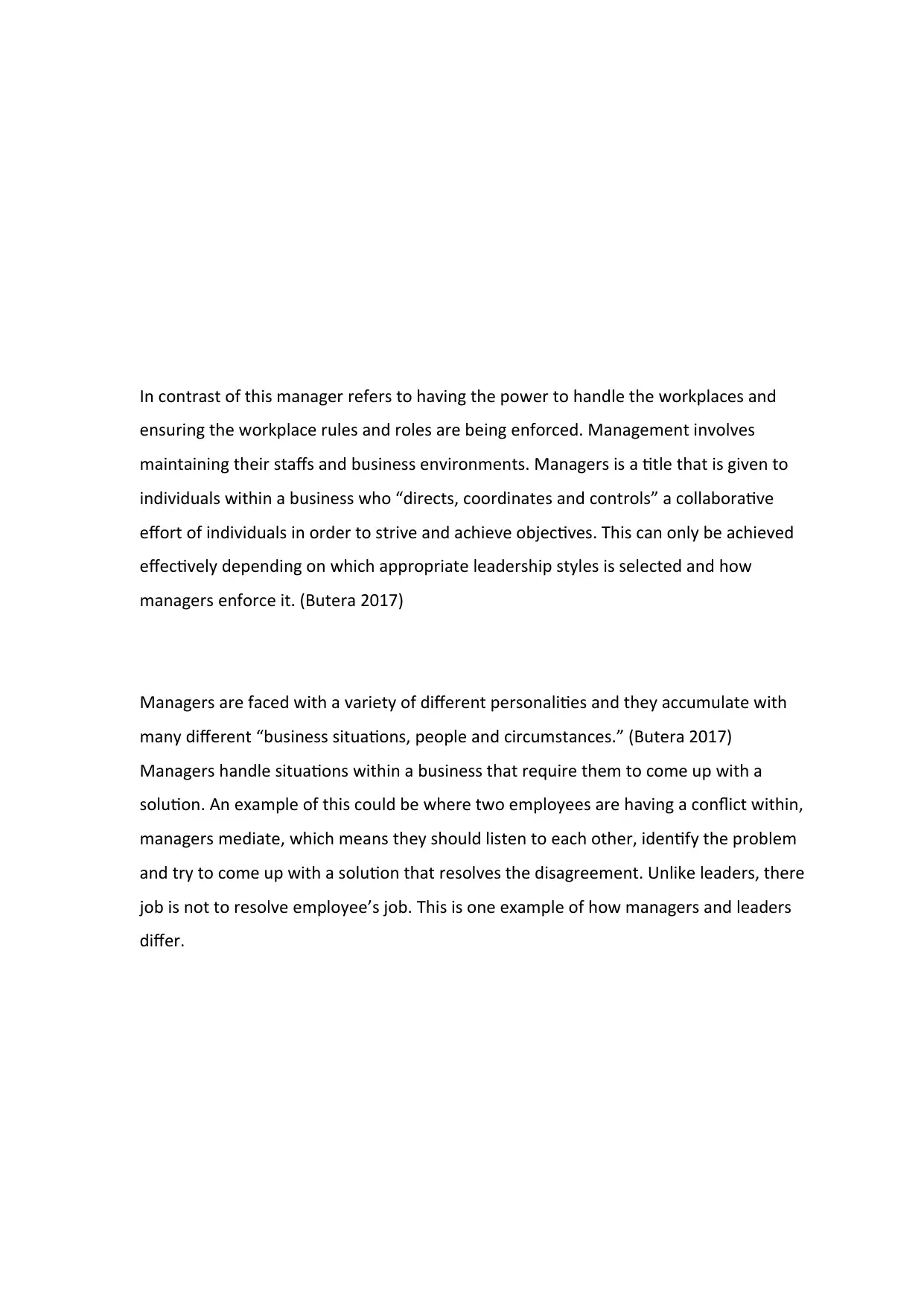
In contrast of this manager refers to having the power to handle the workplaces and
ensuring the workplace rules and roles are being enforced. Management involves
maintaining their staffs and business environments. Managers is a title that is given to
individuals within a business who “directs, coordinates and controls” a collaborative
effort of individuals in order to strive and achieve objectives. This can only be achieved
effectively depending on which appropriate leadership styles is selected and how
managers enforce it. (Butera 2017)
Managers are faced with a variety of different personalities and they accumulate with
many different “business situations, people and circumstances.” (Butera 2017)
Managers handle situations within a business that require them to come up with a
solution. An example of this could be where two employees are having a conflict within,
managers mediate, which means they should listen to each other, identify the problem
and try to come up with a solution that resolves the disagreement. Unlike leaders, there
job is not to resolve employee’s job. This is one example of how managers and leaders
differ.
ensuring the workplace rules and roles are being enforced. Management involves
maintaining their staffs and business environments. Managers is a title that is given to
individuals within a business who “directs, coordinates and controls” a collaborative
effort of individuals in order to strive and achieve objectives. This can only be achieved
effectively depending on which appropriate leadership styles is selected and how
managers enforce it. (Butera 2017)
Managers are faced with a variety of different personalities and they accumulate with
many different “business situations, people and circumstances.” (Butera 2017)
Managers handle situations within a business that require them to come up with a
solution. An example of this could be where two employees are having a conflict within,
managers mediate, which means they should listen to each other, identify the problem
and try to come up with a solution that resolves the disagreement. Unlike leaders, there
job is not to resolve employee’s job. This is one example of how managers and leaders
differ.
⊘ This is a preview!⊘
Do you want full access?
Subscribe today to unlock all pages.

Trusted by 1+ million students worldwide
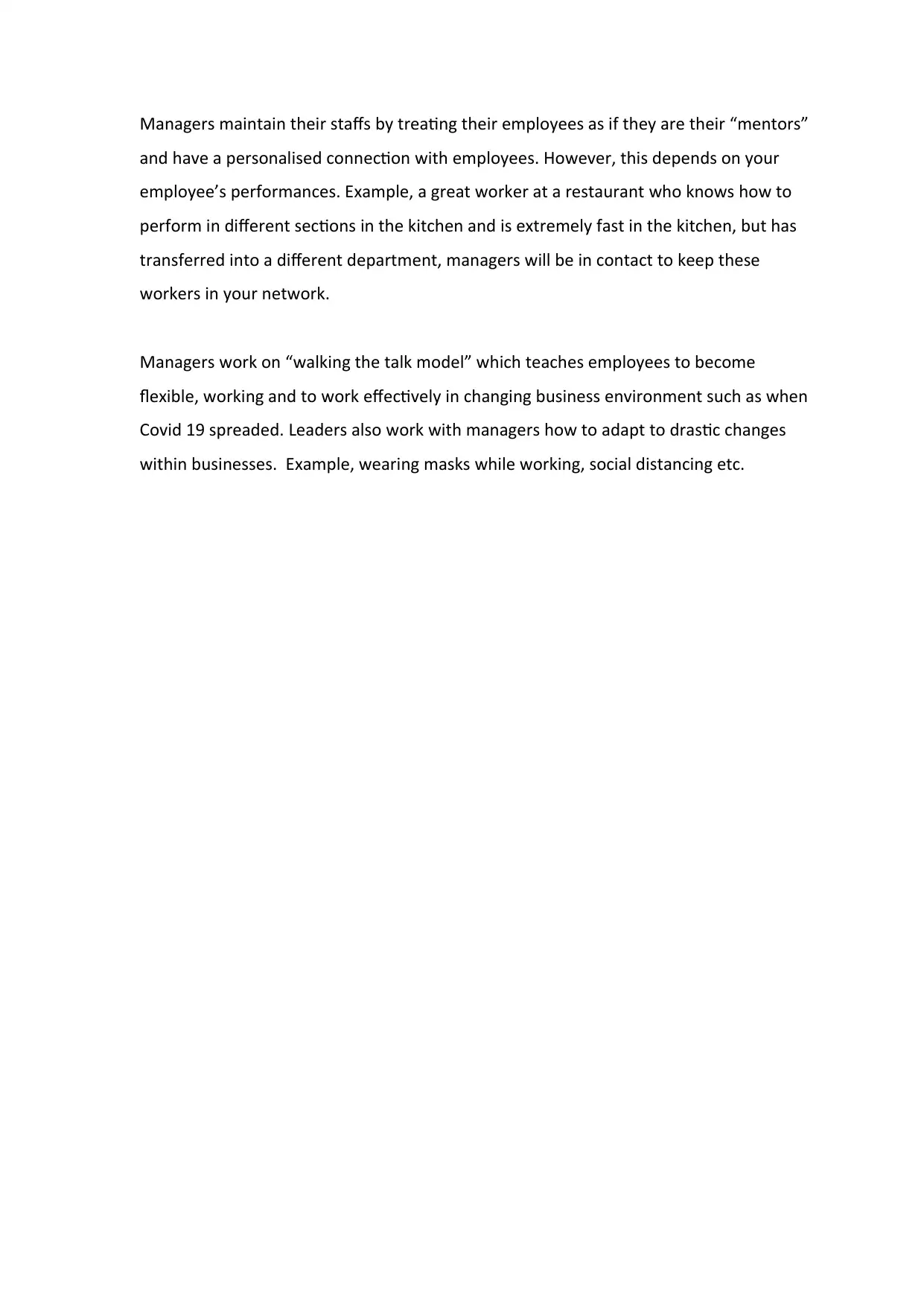
Managers maintain their staffs by treating their employees as if they are their “mentors”
and have a personalised connection with employees. However, this depends on your
employee’s performances. Example, a great worker at a restaurant who knows how to
perform in different sections in the kitchen and is extremely fast in the kitchen, but has
transferred into a different department, managers will be in contact to keep these
workers in your network.
Managers work on “walking the talk model” which teaches employees to become
flexible, working and to work effectively in changing business environment such as when
Covid 19 spreaded. Leaders also work with managers how to adapt to drastic changes
within businesses. Example, wearing masks while working, social distancing etc.
and have a personalised connection with employees. However, this depends on your
employee’s performances. Example, a great worker at a restaurant who knows how to
perform in different sections in the kitchen and is extremely fast in the kitchen, but has
transferred into a different department, managers will be in contact to keep these
workers in your network.
Managers work on “walking the talk model” which teaches employees to become
flexible, working and to work effectively in changing business environment such as when
Covid 19 spreaded. Leaders also work with managers how to adapt to drastic changes
within businesses. Example, wearing masks while working, social distancing etc.
Paraphrase This Document
Need a fresh take? Get an instant paraphrase of this document with our AI Paraphraser
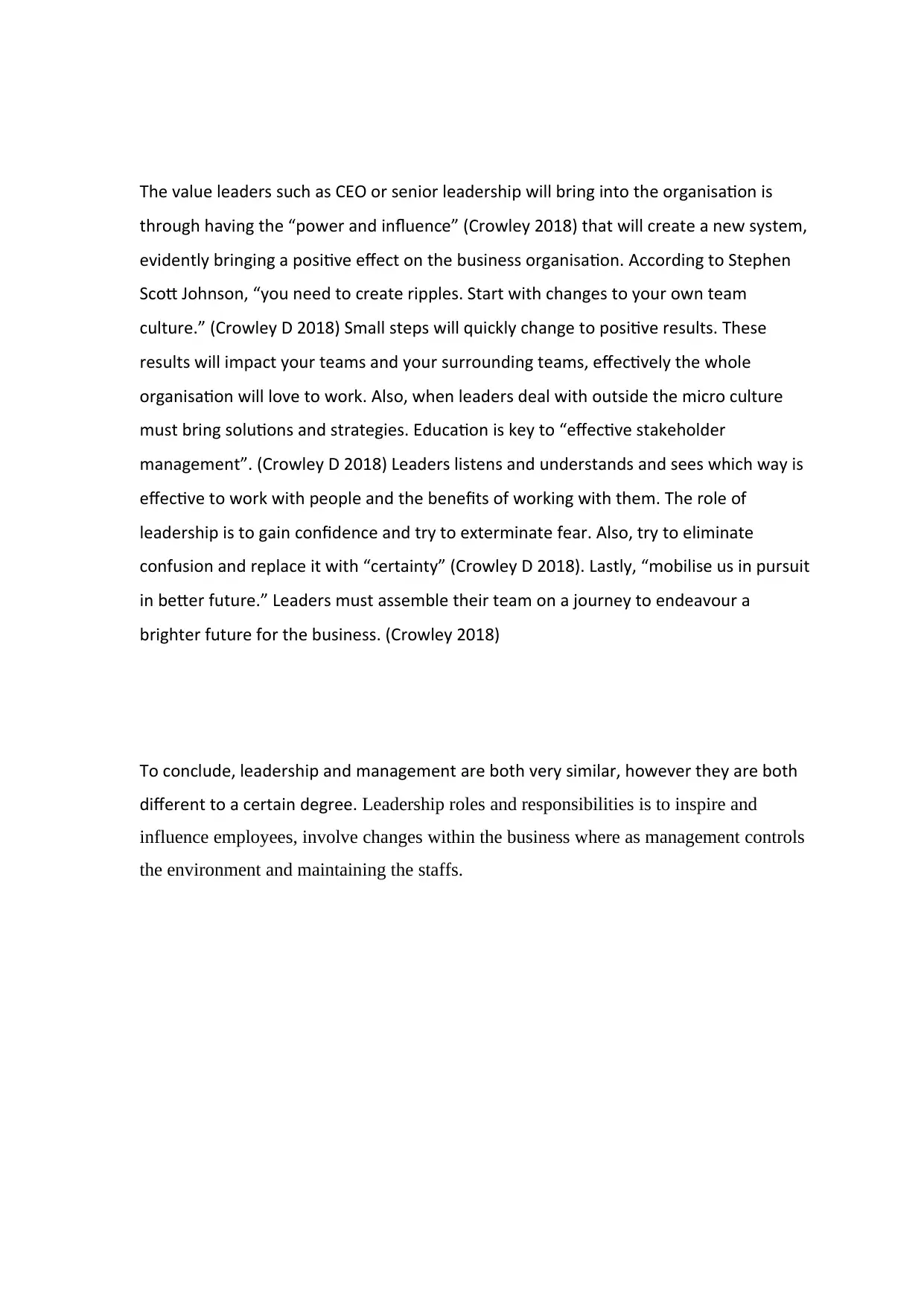
The value leaders such as CEO or senior leadership will bring into the organisation is
through having the “power and influence” (Crowley 2018) that will create a new system,
evidently bringing a positive effect on the business organisation. According to Stephen
Scott Johnson, “you need to create ripples. Start with changes to your own team
culture.” (Crowley D 2018) Small steps will quickly change to positive results. These
results will impact your teams and your surrounding teams, effectively the whole
organisation will love to work. Also, when leaders deal with outside the micro culture
must bring solutions and strategies. Education is key to “effective stakeholder
management”. (Crowley D 2018) Leaders listens and understands and sees which way is
effective to work with people and the benefits of working with them. The role of
leadership is to gain confidence and try to exterminate fear. Also, try to eliminate
confusion and replace it with “certainty” (Crowley D 2018). Lastly, “mobilise us in pursuit
in better future.” Leaders must assemble their team on a journey to endeavour a
brighter future for the business. (Crowley 2018)
To conclude, leadership and management are both very similar, however they are both
different to a certain degree. Leadership roles and responsibilities is to inspire and
influence employees, involve changes within the business where as management controls
the environment and maintaining the staffs.
through having the “power and influence” (Crowley 2018) that will create a new system,
evidently bringing a positive effect on the business organisation. According to Stephen
Scott Johnson, “you need to create ripples. Start with changes to your own team
culture.” (Crowley D 2018) Small steps will quickly change to positive results. These
results will impact your teams and your surrounding teams, effectively the whole
organisation will love to work. Also, when leaders deal with outside the micro culture
must bring solutions and strategies. Education is key to “effective stakeholder
management”. (Crowley D 2018) Leaders listens and understands and sees which way is
effective to work with people and the benefits of working with them. The role of
leadership is to gain confidence and try to exterminate fear. Also, try to eliminate
confusion and replace it with “certainty” (Crowley D 2018). Lastly, “mobilise us in pursuit
in better future.” Leaders must assemble their team on a journey to endeavour a
brighter future for the business. (Crowley 2018)
To conclude, leadership and management are both very similar, however they are both
different to a certain degree. Leadership roles and responsibilities is to inspire and
influence employees, involve changes within the business where as management controls
the environment and maintaining the staffs.
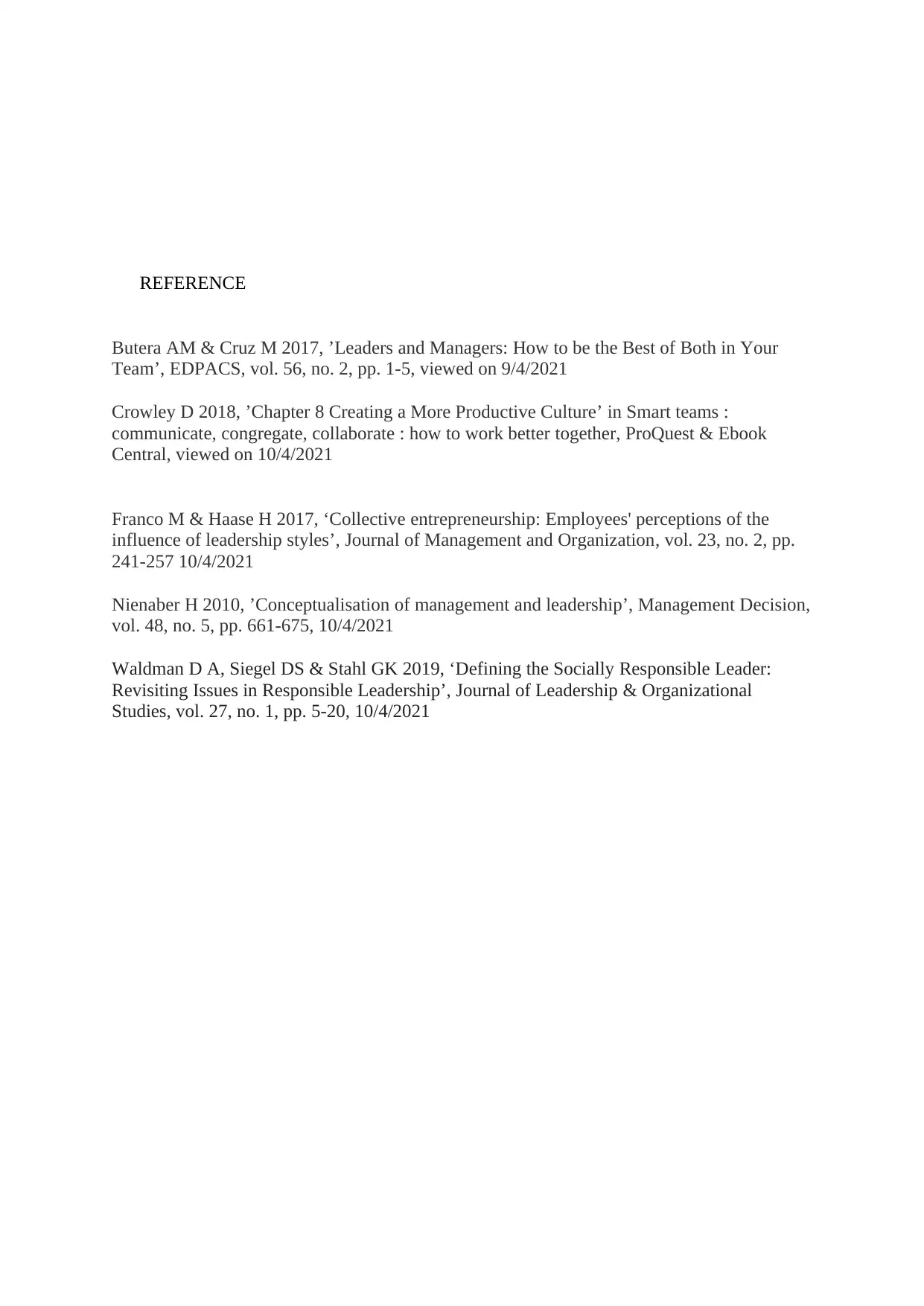
REFERENCE
Butera AM & Cruz M 2017, ’Leaders and Managers: How to be the Best of Both in Your
Team’, EDPACS, vol. 56, no. 2, pp. 1-5, viewed on 9/4/2021
Crowley D 2018, ’Chapter 8 Creating a More Productive Culture’ in Smart teams :
communicate, congregate, collaborate : how to work better together, ProQuest & Ebook
Central, viewed on 10/4/2021
Franco M & Haase H 2017, ‘Collective entrepreneurship: Employees' perceptions of the
influence of leadership styles’, Journal of Management and Organization, vol. 23, no. 2, pp.
241-257 10/4/2021
Nienaber H 2010, ’Conceptualisation of management and leadership’, Management Decision,
vol. 48, no. 5, pp. 661-675, 10/4/2021
Waldman D A, Siegel DS & Stahl GK 2019, ‘Defining the Socially Responsible Leader:
Revisiting Issues in Responsible Leadership’, Journal of Leadership & Organizational
Studies, vol. 27, no. 1, pp. 5-20, 10/4/2021
Butera AM & Cruz M 2017, ’Leaders and Managers: How to be the Best of Both in Your
Team’, EDPACS, vol. 56, no. 2, pp. 1-5, viewed on 9/4/2021
Crowley D 2018, ’Chapter 8 Creating a More Productive Culture’ in Smart teams :
communicate, congregate, collaborate : how to work better together, ProQuest & Ebook
Central, viewed on 10/4/2021
Franco M & Haase H 2017, ‘Collective entrepreneurship: Employees' perceptions of the
influence of leadership styles’, Journal of Management and Organization, vol. 23, no. 2, pp.
241-257 10/4/2021
Nienaber H 2010, ’Conceptualisation of management and leadership’, Management Decision,
vol. 48, no. 5, pp. 661-675, 10/4/2021
Waldman D A, Siegel DS & Stahl GK 2019, ‘Defining the Socially Responsible Leader:
Revisiting Issues in Responsible Leadership’, Journal of Leadership & Organizational
Studies, vol. 27, no. 1, pp. 5-20, 10/4/2021
⊘ This is a preview!⊘
Do you want full access?
Subscribe today to unlock all pages.

Trusted by 1+ million students worldwide
1 out of 6
Related Documents
Your All-in-One AI-Powered Toolkit for Academic Success.
+13062052269
info@desklib.com
Available 24*7 on WhatsApp / Email
![[object Object]](/_next/static/media/star-bottom.7253800d.svg)
Unlock your academic potential
Copyright © 2020–2025 A2Z Services. All Rights Reserved. Developed and managed by ZUCOL.





